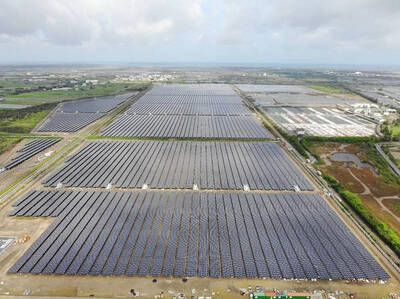This tiny island on Japan’s western frontier has no chain convenience stores. Nature lovers can dive with hammerhead sharks and watch miniature horses graze on a hill.
But the wooded mountain ranges now carry radar sites. A southern cattle ranch has been replaced with the Japanese Ground Self Defense Force’s Camp Yonaguni. Japan and its ally, the US, hold joint military exercises here. Plans are underway to add a new missile unit and expand a small airport and port.
All of the buildup has cemented the island’s as a front line in a potential clash over Taiwan.

Photo: AP
“As a child, I was so proud of this westernmost border island,” said Fumie Kano, an innkeeper on Yonaguni. “But recently, we are repeatedly told this place is dangerous, and I feel so sad.”
The militarization has been especially felt as the island’s population shrinks. There are less than 1,500 local residents. Supporters say new servicemembers arriving are needed for the island’s safety and struggling economy. Opponents like Kano say the military buildup is damaging the environment, making the island’s economy dependent on the military and could provoke an attack.
ON THE FRONT LINE

Photo: AP
Yonaguni is only 110km east of Taiwan, around which China has bolstered military activity. Worried about a conflict, Japan has made a “southwestern shift” in its military posture and accelerated defense buildup and spending around the front line.
Missile units for PAC-3 interceptors have been deployed on Yonaguni and nearby Ishigaki and Miyako islands.
Yonaguni residents find themselves at the center of the geopolitical tension. A recent government plan to deploy more missiles, possibly long-range, has caused unease about the future of the island, even among those who initially supported hosting troops.
Kano, a Yonaguni native, recalls that officials and residents once wanted to improve the economy and environment through commercial exchanges with Taiwan by operating direct ferries between the islands. But that was set aside when a plan to host Japanese troops became an easier alternative to gain government subsidies and protection.
Disagreement about the plan has divided the small community. Support for hosting Japanese troops carried in a 2015 referendum; that meant the island’s fate would be largely decided by the central government’s security policy.
A year later a 160-member coast watch unit was set up to monitor Chinese military activity, with radars built on Mount Inbi and elsewhere. Now there are about 210 troops, including an electro-warfare unit. Servicemembers and their families account for one-fifth of the island’s total population.
The local economy largely depends on the servicemembers and their families who use local shops, schools and community services.
There’s worry on the island about the pace and extent of the militarization, says Kyoko Yamaguchi, a potter.
“Everything is pushed through in the name of the Taiwan emergency, and many feel this is too much.”
A nonfatal crash in October of a Japanese army tilt-rotor aircraft Osprey during a joint exercise with the US military on the island also caused apprehension.
JAPAN AND CHINA’S MILITARIES
Japan’s air and maritime forces in Okinawa’s prefectural capital of Naha are key to protecting the country’s southwestern airspace and territorial waters.
The Naha-based Southwestern Air Defense Force is the busiest of Japan’s four regional air forces. In fiscal 2023, the force was scrambled 401 times, or 60 percent of the national total of 669, mostly against the Chinese, according to the Defense Ministry.
Rear Admiral Takuhiro Hiragi, commander of Fleet Air Wing 5 of the Japan Maritime Self-Defense Force, says his group’s mission is to fly P-3C aircraft over the East China Sea near Okinawa and its remote islands, including Yonaguni, and the Japanese-controlled Senkaku island, known as the Diaoyutais (釣魚台) in Taiwan.
“We have to be mobile, quick and thorough to keep tabs in this region,” Hiragi said, noting the presence of key sea lanes in the area, including those that China uses to navigate the Pacific Ocean. “We watch over their exercises, not only near Taiwan but wherever necessary.”
Defense officials say China has been accelerating its military activities in the area between Taiwan and Yonaguni.
In August, a Chinese Y-9 reconnaissance plane briefly violated Japanese airspace off the southern main island of Kyushu, prompting Japan’s military to scramble fighter jets and warn the plane. A Chinese survey ship separately violated Japanese territorial waters off a southern island days later. In September, the Chinese aircraft carrier Liaoning and two destroyers sailed between Yonaguni and nearby Iriomote, entering a band of water just outside of Japan’s territorial waters.
GROWING FEAR
Yonaguni fisherfolk, who closely monitor foreign vessels, have been among the first to see the growing Chinese military activity.
In 2022, several ballistic missiles China fired as part of an exercise landed off Japan’s southwestern waters following then-US house speaker Nancy Pelosi’s Taiwan visit in August. One of them landed just 80 kilometers from Yonaguni while more than 20 local fishing boats were operating.
Though it caused no injuries or damage, the Chinese drills kept fisherfolk from operating for a week, Yonaguni fisheries association chief and town assembly member Shigenori Takenishi said. “It was an extremely dangerous exercise that really made us feel China’s potential threat right next to us.”
Fear of a Taiwan war rekindles bitter memories here of the Battle of Okinawa, in which about 200,000 people, nearly half of them civilians, were killed. Historians say the army sacrificed Okinawa to defend Japan’s mainland. Today Okinawa ‘s main island hosts more than half of the 50,000 American troops in Japan.
“Being at the center of this issue is very stressful for residents,” said shopkeeper Takako Ueno. “I don’t want people to imagine this beautiful island turning into a battlefield.”
To keep that from happening Yonaguni needs to be fortified, says Mayor Kenichi Itokazu, a military buildup advocate who has campaigned for the deployment of more Japanese troops for decades.
What happens in an emergency?
Some residents feel uneasy about their vulnerability, even amid the military buildup.
A government evacuation plan last year showed moving 120,000 people from five remote islands, including Yonaguni, to Japan’s main islands would take at least six days. Some question whether such an evacuation is even possible.
Itokazu, the mayor, wants to build a shelter in the basement of a new town hall and to expand the Higawa port for evacuation by ship, a plan opposed by environmentalists who say there are rare marine species there.
But there’s skepticism from some.
“It’s absurd,” Kano said of the evacuation plan, because all of Japan would be in danger if Okinawa is dragged into fighting. “I just hope the money will be spent on policies that will help the people in Yonaguni live peacefully.”

Every now and then, it’s nice to just point somewhere on a map and head out with no plan. In Taiwan, where convenience reigns, food options are plentiful and people are generally friendly and helpful, this type of trip is that much easier to pull off. One day last November, a spur-of-the-moment day hike in the hills of Chiayi County turned into a surprisingly memorable experience that impressed on me once again how fortunate we all are to call this island home. The scenery I walked through that day — a mix of forest and farms reaching up into the clouds

With one week left until election day, the drama is high in the race for the Chinese Nationalist Party (KMT) chair. The race is still potentially wide open between the three frontrunners. The most accurate poll is done by Apollo Survey & Research Co (艾普羅民調公司), which was conducted a week and a half ago with two-thirds of the respondents party members, who are the only ones eligible to vote. For details on the candidates, check the Oct. 4 edition of this column, “A look at the KMT chair candidates” on page 12. The popular frontrunner was 56-year-old Cheng Li-wun (鄭麗文)

“How China Threatens to Force Taiwan Into a Total Blackout” screamed a Wall Street Journal (WSJ) headline last week, yet another of the endless clickbait examples of the energy threat via blockade that doesn’t exist. Since the headline is recycled, I will recycle the rebuttal: once industrial power demand collapses (there’s a blockade so trade is gone, remember?) “a handful of shops and factories could run for months on coal and renewables, as Ko Yun-ling (柯昀伶) and Chao Chia-wei (趙家緯) pointed out in a piece at Taiwan Insight earlier this year.” Sadly, the existence of these facts will not stop the

Oct. 13 to Oct. 19 When ordered to resign from her teaching position in June 1928 due to her husband’s anti-colonial activities, Lin Shih-hao (林氏好) refused to back down. The next day, she still showed up at Tainan Second Preschool, where she was warned that she would be fired if she didn’t comply. Lin continued to ignore the orders and was eventually let go without severance — even losing her pay for that month. Rather than despairing, she found a non-government job and even joined her husband Lu Ping-ting’s (盧丙丁) non-violent resistance and labor rights movements. When the government’s 1931 crackdown